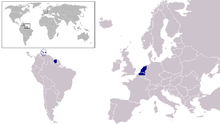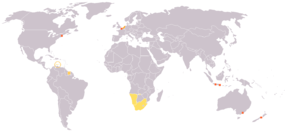- Dutch Language Union
-
Dutch Language Union
Nederlandse Taalunie (Dutch)Headquarters The Hague, Netherlands Official languages Dutch Member States Leaders - Executive Secretariat Marja van Bijsterveldt Establishment - Treaty on the Dutch Language Union 9 September 1980 Website
taalunieversum.orgThe Dutch Language Union (Dutch:
 Nederlandse Taalunie (help·info), NTU) is an international institution for discussing issues regarding the Dutch language. It was founded on 9 September 1980 by the Netherlands and Belgium (in respect of the Flemish Community). Suriname has been an associate member of the Taalunie since 2005.
Nederlandse Taalunie (help·info), NTU) is an international institution for discussing issues regarding the Dutch language. It was founded on 9 September 1980 by the Netherlands and Belgium (in respect of the Flemish Community). Suriname has been an associate member of the Taalunie since 2005.Contents
Common Dutch
Main article: Dutch languageStandard Dutch (Standaardnederlands or Algemeen Nederlands, often abbreviated to AN) is the standard language as it is taught in schools and used by authorities in the Netherlands, Flanders, Suriname, and Aruba, as well as the Netherlands Antilles. The Dutch Language Union defines what is AN and what is not. Since efforts to “uplift” people came to be considered rather presumptuous, the earlier name Algemeen Beschaafd Nederlands (“Common Civilized Dutch”) and its abbreviation, ABN, have been replaced with Algemeen Nederlands and thus AN. The implicit insinuation that people speaking dialects or with an accent were not civilized was thus removed.[citation needed]
Word list
An important change that was carried out by the Dutch Language Union was the modification of Dutch orthography in 1995, regarding in particular the writing of the interfix -n in many compounds. Among the Union’s publications is the well-known Word list of the Dutch language (Woordenlijst Nederlandse taal), commonly known as the “Groene boekje” ("Green booklet", because of its distinctive green colour). The green booklet is the official orthographic and grammatical reference of the Dutch language. It is laid out like a dictionary, including plural forms and spelling but without actual word definitions.
The most recent version of the Green Booklet appeared in 2005, including a somewhat controversial spelling reform which was not received well in general because a part of the spelling reforms of 1996 was changed again. In December 2005, most of the Dutch mainstream media announced a boycott. In August 2006, they released a 'White book' as their own, subtly different guideline. Currently these two spellings are both in use, sometimes confusing people; the 'green' one is used by schools and officials, the 'white' one by papers, magazines and television stations.
In Belgium, on the other hand, the spelling reform was generally accepted without protest.
Dictionary
The Van Dale dictionary is accepted as the official Dutch dictionary. Commonly named the Dikke Van Dale ("fat Van Dale" due to its size) the dictionary is split into three tomes (A-I, J-R, S-Z) and is usually updated every 7–8 years. The 14th edition was published in 2005.
The Woordenboek der Nederlandsche Taal is an historic dictionary that includes all words used from 1500 to the present day.
Work began in 1864 and was finished in 1998 when the last volume was published. It has 43 volumes, needing about 3m if placed on a shelf, with about 400,000 words on 49,255 pages. In 2001, three additional volumes where published containing mostly words from the 20th century that were not included in the previous 43 volumes. This dictionary is published by Instituut voor Nederlandse Lexicologie and can be found online.
Organization
The organization is also responsible for the external linguistic policy of the Netherlands and Flanders and is active in Indonesia and South Africa, two countries with historic links with the Dutch language. Nevertheless, cooperation with South Africa is not limited to the Afrikaans language but aimed also at fostering multilingualism.
The purposes of the organization are limited to Dutch language and Dutch-language literature, and are hence not as wide as those of the Community of Portuguese Language Countries, La Francophonie or the Organization of Ibero-American States.
The Treaty on the Dutch Language Union foresees the possibility that the Kingdom of the Netherlands extends application to NTU member's parts outside Europe (i.e. the Netherlands Antilles and Aruba) but this has not happened, although the Netherlands Antilles has signed a "Framework Agreement" in 2007. The organs of the NTU are its Committee of Ministers (composed of the ministers of education and culture of the Dutch and Flemish Governments), its Secretariat-General, an Interparliamentary Committee (composed of members of the States-General of the Netherlands and the Flemish Parliament) and a Dutch Language and Literature Council (composed of twelve independent experts). There are specific arrangements for the participation of Suriname in the organization's inner workings.
Member states
As the basis of the Taalunie is a treaty between the Kingdom of the Netherlands and the Kingdom of Belgium, those two sovereign states constitute the Union. For the Kingdom of the Netherlands, the treaty is only applicable to its European territory. The treaty allows for two types of extensions:
- membership of other sovereign states through an "association membership"[1]
- extension to other territories of the Kingdom of the Netherlands (presently: Aruba, Bonaire, Curaçao, Caribbean Netherlands).[1]
As of January 2011[update], the Dutch Language Union included the following member states:
 Belgium
Belgium Netherlands
Netherlands Suriname (associate member)
Suriname (associate member)
The three Caribbean countries of the Kingdom of the Netherlands are designated as candidate member states:[2]
See also
- Dutch orthography
- List of language academies
- OpenTaal
References
- ^ a b "Verdrag tussen het Koninkrijk der Nederlanden en het Koninkrijk Belgie inzake de Nederlandse Taalunie, Brussel" (in Dutch). Netherlands government portal. 1980-09-09. http://wetten.overheid.nl/BWBV0002947/geldigheidsdatum_16-04-2011.
- ^ http://taalunieversum.org/taalunie/wie_zijn_wij/
External links
Dutch Language Union Countries and languages lists Languages by continent Languages by country Unions based on language Arab League (Arabic) · Dutch Union (Dutch) · Francophonie (French) · Latin Union (Romance languages) · Hispanosphere, Hispanidad (Spanish) · CPLP, PALOP (Portuguese) · TÜRKSOY/Turkic Council (Turkic languages)Countries by language Languages by population Languages by family Dutch Empire Colonies and trading posts of the Dutch East India Company (1602-1798) GovernoratesAmbon · Banda · Batavia · Cape Colony · Ceylon · Coromandel · Formosa · Northeast coast of Java · Makassar · Malacca · MoluccasDirectoratesCommandmentsResidenciesSettlements with an opperhoofdColonies and trading posts of the Dutch West India Company (1621-1792) Colonies in the AmericasAcadia · Berbice† · Cayenne · Curaçao and Dependencies · Demerara · Essequibo · Brazil · New Netherland · Pomeroon · Sint Eustatius and Dependencies · Suriname‡ · Tobago · Virgin IslandsTrading posts in Africa† Governed by the Society of Berbice · ‡ Governed by the Society of SurinameSettlements of the Noordsche Compagnie (1614-1642) SettlementsColonies of the Kingdom of the Netherlands (1815-1962) Until 1825Until 1853Until 1872Until 1945Until 1954Until 1962† Became constituent countries of the Kingdom of the Netherlands; Suriname gained full independence in 1975, Curaçao and Dependencies was renamed to the Netherlands Antilles, which was eventually dissolved in 2010.Kingdom of the Netherlands (1954-Present) Constituent countriesPublic bodies of the NetherlandsCategories:- Dutch language
- Language regulators
Wikimedia Foundation. 2010.


